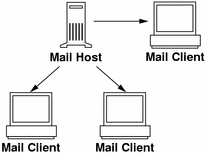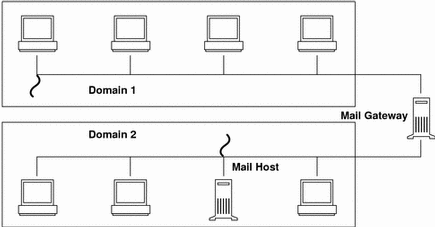Planning Your Mail System
This section describes four basic types of mail configurations and briefly outlines the tasks required to set up each configuration. You might find this section useful if you need to set up a new mail system or if you are expanding an existing one. The configurations start with the most basic case (mail completely local, no connection to the outside world) and increase in complexity to a two-domain configuration with a mail gateway. The first decision you should make is which one of these configurations you would like to employ. The following configurations are covered:
As system administrator, you should decide on a policy for updating aliases and for forwarding mail messages. You might set up an aliases mailbox as a place for users to send requests for mail forwarding and for changes to their default mail alias. If your system uses NIS or NIS+, you can administer forwarding rather than forcing users to manage it themselves.
Local Mail Only
The simplest mail configuration, shown in Figure 34-1, is one mail host with two or more workstations connected to it. Mail is completely local. All the clients store mail on their local disks and act as mail servers. Mail addresses are parsed using the /etc/mail/aliases files.
Figure 34-1 Local Mail Configuration

To set up this kind of mail configuration, you need:
-
The default /etc/mail/sendmail.cf file on each mail client system (no editing required)
-
A server designated as the mail host (add mailhost.domainname to the /etc/hosts file on the mail host; then if you are not running NIS or NIS+, add the mail host IP address line to the /etc/hosts file of all mail clients)
-
Matching /etc/mail/aliases files on any system that has a local mailbox (unless you are running NIS or NIS+)
-
Enough space in /var/mail on each mail client system to hold the mailboxes
Local Mail in Remote Mode
In this configuration, each mail client mounts its mail from one mail server that provides mail spooling for client mailboxes. This server can also be the mail host. This configuration assists the backup of the mailboxes for each client.
To set up this kind of mail configuration, you need:
-
The default /etc/mail/sendmail.cf file on each mail client system (no editing required)
-
A server designated as the mail host (add mailhost.domainname to the /etc/hosts file on the mail host; then if you are not running NIS or NIS+, add the mail host IP address line to the /etc/hosts file of all mail clients)
-
Matching /etc/mail/aliases files on any system that has a local mailbox (unless you are running NIS or NIS+)
-
Entries in each mail client's /etc/vfstab file or /etc/auto_direct (if autofs is used) to mount the /var/mail directory
-
Enough space in /var/mail on the mail server to hold the client mailboxes
Local Mail and a Remote Connection
The most common mail configuration in a small network is shown in Figure 34-2. One system is the mail server, the mail host, and the mail gateway to the outside world. Mail is distributed using the /etc/mail/aliases files. No name service is required.
Figure 34-2 Local Mail Configuration With a UUCP Connection

To set up this kind of a mail configuration, assuming that the mail clients mount their mail files from /var/mail on the mail host, you need:
-
The main.cf file on the mail gateway (no editing required if MX records are used)
-
The default /etc/mail/sendmail.cf file on each mail client system (no editing required)
-
A server designated as the mail host (add mailhost.domainname to the /etc/hosts file on the mail host; if you are not running NIS or NIS+, add the mail host IP address line to the /etc/hosts file of all mail clients)
-
Matching /etc/mail/aliases files on any system that has a local mailbox (unless you are running NIS or NIS+)
-
Entries in each mail client's /etc/vfstab file or /etc/auto_direct (if autofs is used) to mount the /var/mail directory when mailboxes are located on the mail host
-
Enough space in /var/mail on the mail server to hold the client mailboxes
Two Domains and a Gateway
The mail configuration shown in Figure 34-3 has two domains and a mail gateway. In this configuration, the mail server, the mail host, and the mail gateway (or gateways) for each domain are likely to be different systems. To assist the process of administering and distributing mail, a name service is used.
Figure 34-3 Two Domains and a Gateway

To set up this kind of a mail configuration, assuming that the mail clients mount their mail files from /var/mail on the mail host, you need:
-
Complex gateway systems requiring a customized sendmail.cf file with special rules added
-
The main.cf file on the mail gateway (no editing required if you use MX records)
-
A server designated as the mail host (add mailhost.domainname to the /etc/hosts file on the mail host; if you are not running NIS or NIS+, add the mail host IP address line to the /etc/hosts file of all mail clients)
-
Matching /etc/mail/aliases files on any system that has a local mailbox (unless you are running NIS or NIS+)
-
An alias entry for each user, to point to where the mail is stored, in mail_aliases.org_dir for NIS+ or the aliases map for NIS
-
The default /etc/mail/sendmail.cf file on each mail client system (no editing required)
-
Entries in each mail client's /etc/vfstab file or /etc/auto_direct (if autofs is used) to mount the /var/mail directory when mailboxes are located on the mail host
-
Enough space in /var/mail on the mail server to hold the client mailboxes
- © 2010, Oracle Corporation and/or its affiliates
